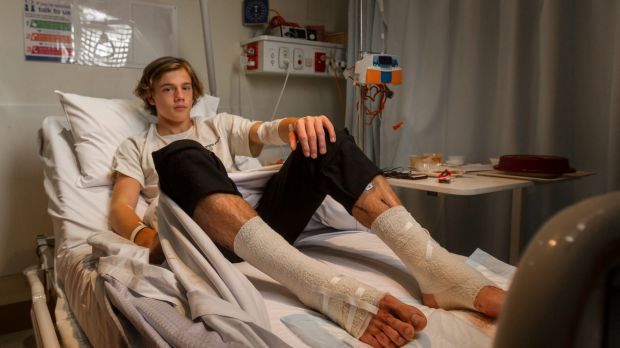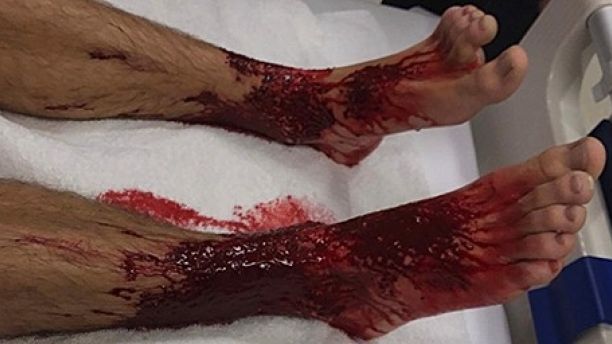It looks like you're using an Ad Blocker.
Please white-list or disable AboveTopSecret.com in your ad-blocking tool.
Thank you.
Some features of ATS will be disabled while you continue to use an ad-blocker.
share:
originally posted by: Xtrozero
originally posted by: GuidedKill
Wow talk about being rubbed raw....That would need a little more than some gold bond to cure!!!
50 years ago we would just rub some dirt on it and carry on...
50 years ago birth control was simply called pulling out....
Times they are a changing!!
edit on p2808p31Mon, 07 Aug 2017 13:28:22 -0500281122 by pimptriggs because: (no reason given)
originally posted by: pimptriggs
That looks like something out of a VFX microscope scene of a horror movie like the Andromeda strain or Tremors.
When my daughter told me about this story today, I said immediately "Did it happen in the Pacific?"
I think a few here think the same, but my idea diverges from mutation due to Fukushima; I think these are creatures who needed to change habitat due to Fukushima. We might see more news species in the coming years because of that.
I think a few here think the same, but my idea diverges from mutation due to Fukushima; I think these are creatures who needed to change habitat due to Fukushima. We might see more news species in the coming years because of that.
The article said the beach is popular and people swim there everyday. I wonder why more people aren't being bitten. What about that boy is different
than other people who swim there and why are these creatures confined to just one incident at one location? Interesting post, creeps me out, gonna be
on high alert the next time I'm in any body of water. Haha.
a reply to: GuidedKill
So. . .
In the nation of Nope-istan, someone went to Nope Beach and was bitten by hundreds of tiny Nope-isms.

This is me running away from the images. . . .

So. . .
In the nation of Nope-istan, someone went to Nope Beach and was bitten by hundreds of tiny Nope-isms.

This is me running away from the images. . . .

originally posted by: Xtrozero
originally posted by: GuidedKill
Wow talk about being rubbed raw....That would need a little more than some gold bond to cure!!!
50 years ago we would just rub some dirt on it and carry on...
Being and old codg I would say education. In the old days, we saw what we saw knew what we knew or were told. Today we look things up, sand fleas for instance we know carry parasites. EXAMPLE: Sand flies infect U.S. forces with parasite that leaves them with 'Baghdad Boil'
www.washingtonpost.com...
Google sand fleas carry....there are numerous horrors.
Smart people get treated for black legged tick bite and so on.
Looks like pretty deep gashes

edit on 7-8-2017 by SeaWorthy because: (no reason given)
well, that's reason #304 why i won't go in the sea. but it's nice to look at (the sea, not the minced feet).
edit on 7 8 2017 by RoScoLaz5
because: add words

I was so tempted to say fake, but as he has been to 2 hospitals, so i guess not. But thats a lot of blood on his right leg for those little critters to cause in such a short space of time, looks more like piranhas have had leg of man for dinner.
As no-one had this happen to them, could it have been 2 stage process? Could a jelly fish (or other creature) have caused the initial cuts and then these critters moved in after?
Would also have liked to have seen photos of the cleaned up wound, it would of helped.
edit on 7-8-2017 by Moohide because: Spelling
His toes are ok and looks like its just affected on top of his feet and round his ankles. Odd.
originally posted by: Moohide
I was so tempted to say fake, but as he has been to 2 hospitals, so i guess not. But thats a lot of blood on his right leg for those little critters to cause in such a short space of time, looks more like piranhas have had leg of man for dinner.
As no-one had this happen to them, could it have been 2 stage process? Could a jelly fish (or other creature) have caused the initial cuts and then these critters moved in after?
Would also have liked to have seen photos of the cleaned up wound, it would of helped.
I'd say those are real. My parents bought an old farmhouse in France - before it was bought by Parisians as a holiday home, it had been used by a farmer who used to take his livestock indoors every winter. When we first moved in all the old bedframes had large plastic sheets underneath them. When I stayed there I'd get flea-bites. They would start as tiny pin-pricks, get red, inflame, then itch like hell, break open and just ooze blood. The last two would just repeat until there was deep hole. All due to fleas. Worst time, my foot would swell up, feel super hot, and when I lifted up the blankets, there were 20+ fleas on my foot with blood all over the blankets. Had to clean the rooms up by digging out all the dust from between the floorboard cracks.
Spent my childhood swimming in the area and have never seen anything like this. Just unlucky I guess. My money is on him standing very close to dead
marine life being consumed by the critters and he got there just in time for dessert.
[url]http://www.msn.com/en-au/news/australia/flesh-eating-bugs-at-brighton-beach-what-really-ate-sam-and-why/ar-AApAVtv?li=AAavLaF&ocid=spartandhp[/ur l]
Museum marine scientist Dr Genefor Walker-Smith has examined specimens collected by Sam's father, Jarrod Kanizay – using bites of meat as lures – at Brighton on Sunday night, and said the creatures were sea fleas, not sea lice as first thought. Sea fleas are scavenging amphipod crustaceans belonging to the lysianassid group. The bad news is that they're found all over Port Phillip Bay and all over the world.
[url]http://www.msn.com/en-au/news/australia/flesh-eating-bugs-at-brighton-beach-what-really-ate-sam-and-why/ar-AApAVtv?li=AAavLaF&ocid=spartandhp[/ur l]
I have lived on coastal areas of AU most of my life and I've never seen anything like this. I'm pretty sure I'd be more careful of putting my legs in
the water if I knew they could be eaten alive. Sand fleas just leave itchy spots like normal fleas, they don't eat the flesh off of you. Looks to me
like either some sort of new species or he was attacked by something else without realizing it. Notice the part of the article which states:
"Both at Sandringham Hospital and also Dandenong Hospital, no one had seen anything like this before and they're all pretty fascinated by it."
edit on 7/8/2017 by ChaoticOrder because: (no reason given)
new topics
-
D.B. Cooper mystery may be solved
General Conspiracies: 1 hours ago
top topics
-
D.B. Cooper mystery may be solved
General Conspiracies: 1 hours ago, 5 flags
active topics
-
Petition Calling for General Election at 564,016 and rising Fast
Political Issues • 97 • : BrucellaOrchitis -
D.B. Cooper mystery may be solved
General Conspiracies • 3 • : Shoshanna -
I thought Trump was the existential threat?
World War Three • 81 • : network dude -
Joe Biden Dabs Away Tears at Farewell White House Dinner
Politicians & People • 27 • : chr0naut -
Results of the use of the Oreshnik missile system in Dnepropetrovsk
World War Three • 241 • : andy06shake -
Why isn't Psychiatry involved?
Social Issues and Civil Unrest • 14 • : BrucellaOrchitis -
Well, here we go red lines crossed Biden gives the go ahead to use long range missiles
World War Three • 396 • : andy06shake -
-@TH3WH17ERABB17- -Q- ---TIME TO SHOW THE WORLD--- -Part- --44--
Dissecting Disinformation • 3384 • : brewtiger123 -
BIDEN Admin Begins Planning For January 2025 Transition to a New President - Today is 4.26.2024.
2024 Elections • 59 • : WeMustCare -
DOJ Special Counsel Robert HUR Says JOE BIDEN Can Be ARRESTED After Jan 20th 2025.
Above Politics • 30 • : WeMustCare

